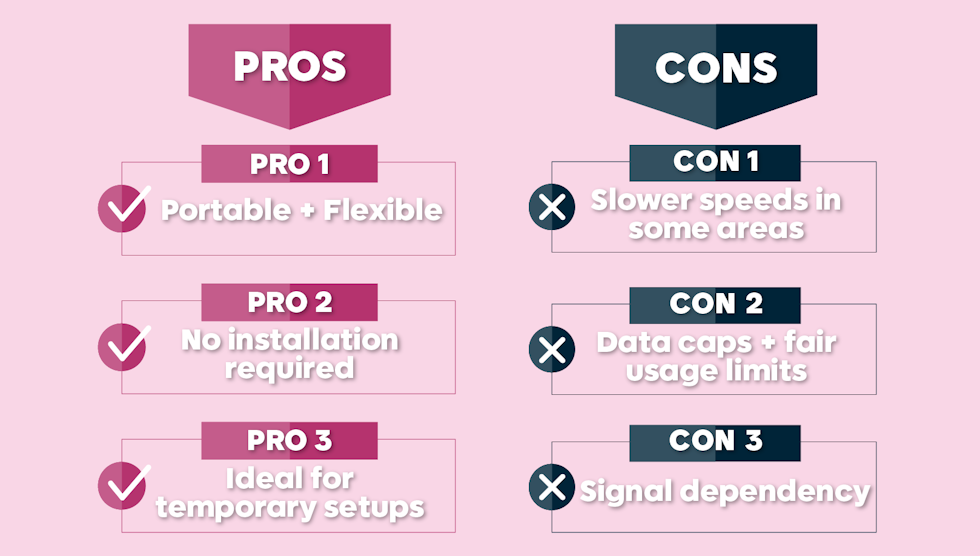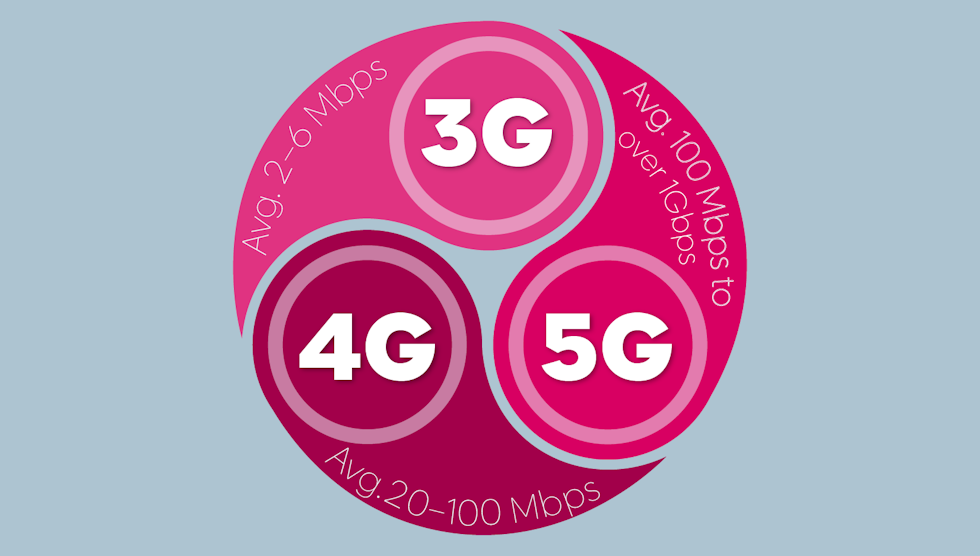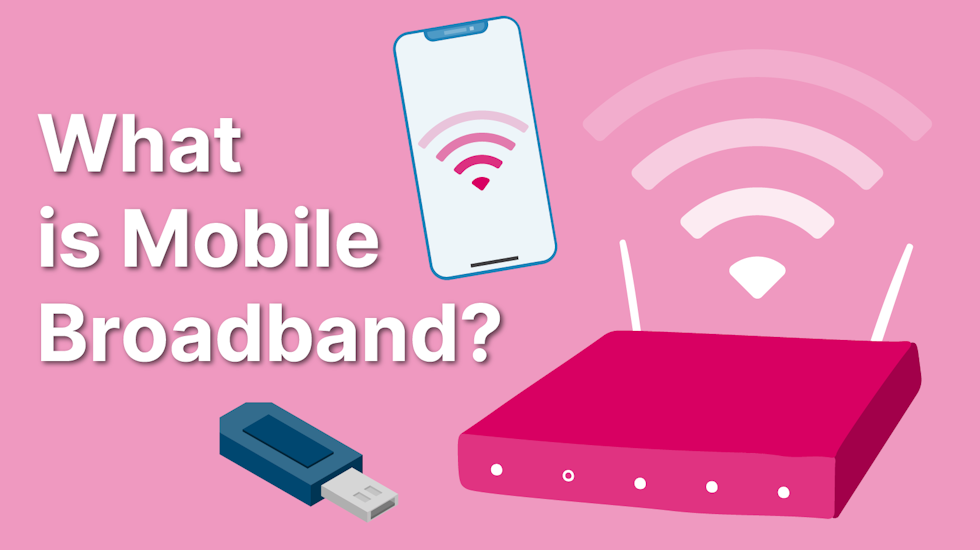Home internet without wires – meet mobile broadband.
Mobile broadband is a flexible, wireless way to access the internet without relying on traditional fixed-line connections. It’s ideal for people on the move, those without access to fibre, or anyone needing a portable internet solution.
That’s a very brief overview of mobile broadband, so let’s take a deeper dive as we break down exactly what mobile broadband is, how it works, and who it’s best suited for.
What is Mobile Broadband? – Definition
Mobile broadband is a way of connecting to the internet using a mobile network rather than a fixed phone line or fibre connection. This means you can access the internet almost anywhere there’s mobile signal, without needing to be tied to a physical location.
Instead of using a landline or fibre optic cable to bring broadband into your home, mobile broadband uses a SIM card, just like a mobile phone. This SIM is inserted into a compatible device, such as a compatible home hub, USB dongle, a portable MiFi router, or directly into a tablet or laptop that supports cellular connectivity. The device then connects to your mobile network provider, giving you internet access through mobile data.
One of the biggest advantages of mobile broadband is its flexibility. Since it’s not tied to a fixed address, you can take it with you wherever you go – whether you’re commuting, working remotely, or just need backup internet access.
It’s a particularly popular solution for people who travel frequently, live in rural areas with limited broadband infrastructure, or want to avoid lengthy contracts or installations.
How Does Mobile Broadband Work?

Mobile broadband works by connecting your device to the internet using a mobile network. Instead of using a cable to connect to your ISP (internet service provider), your device accesses data through a mobile signal – the same kind your phone uses.
Depending on your device, this connection might come via a 4G/5G home broadband hub, USB dongle, a wireless MiFi router, or a SIM card installed in a tablet or laptop.
Once connected, the mobile broadband device converts that signal into usable internet for your device. 4G/5G home hubs and MiFi routers can even broadcast a Wi-Fi signal, allowing multiple devices to connect at once, much like a home broadband router but on a smaller, portable scale.
Coverage, signal strength, and connection speed will depend on the mobile network provider and the available infrastructure in your area – particularly whether you’re connected to 3G, 4G or 5G.
Types of Mobile Broadband
There are several ways you can use mobile broadband, each suited to different needs:
4G/5G home broadband hubs
A WiFi router that uses mobile networks to provide internet throughout your home. Typically, these need a device installed somewhere on the outside of the home which is used to pick up the nearest mobile network, then a cable runs inside and into a router.
This is very similar to standard wired connections except without the need of a phone line installed, as the connection is picked up wirelessly via the outside device.
USB Dongles
Small plug-in devices that slot into your laptop’s USB port. Great for solo users who want quick and easy access to mobile data without needing Wi-Fi.
MiFi devices (mobile Wi-Fi routers)
Portable routers that create a personal Wi-Fi hotspot by connecting to a mobile network. These are ideal for sharing a connection with multiple devices, such as phones, laptops, and tablets.
Data-only SIM cards
SIMs designed solely for internet use, without calling or texting capabilities. Often used in tablets, SIM-enabled laptops, or inside mobile broadband routers.
Tethering via smartphone
Turning your mobile phone into a hotspot is another form of mobile broadband. Your phone shares its data connection with other devices via Wi-Fi or USB.
Pros and Cons of Mobile Broadband

As with any broadband, there are pros and cons to opting for that certain connection.
Pros
- Portable and flexible: Mobile broadband can be used virtually anywhere with mobile signal coverage. Whether you’re commuting, travelling, or working remotely, it offers reliable access on the go.
- No installation required: Unlike fixed broadband, there’s no need for engineer visits or waiting times. You can be online in minutes once your SIM or device arrives.
Short-term contracts and PAYG options: Many providers offer 30-day rolling contracts or pay-as-you-go options, giving users freedom without long-term commitments. - Ideal for temporary setups: Perfect for students, renters, or people in temporary accommodation where installing fixed-line broadband might not be practical or allowed.
Cons
- Slower speeds in some areas: Mobile broadband can be less reliable than fibre, especially in rural or congested areas where signal strength is weak or shared among many users.
- Data caps and fair usage limits: Many plans come with usage limits or throttling after a certain threshold, which can be problematic for heavy streamers or gamers.
- Signal dependency : Performance can fluctuate depending on your location, the weather, or even the construction of nearby buildings. If you’re in a signal blackspot, your internet might struggle.
- Not always cost-effective for heavy users: If you use a lot of data (e.g. for video streaming, gaming, or downloading large files), mobile broadband can end up being more expensive than fixed-line deals.
Who is mobile broadband best for?
Mobile broadband is especially suited for people who need flexibility and portability. For example, frequent travellers or commuters who want internet access on trains or while staying in hotels can benefit from a reliable MiFi device or data SIM.
It’s also great for students and renters who may not want to commit to a 12 or 18-month broadband contract, particularly if they move often.
Additionally, it can be a valuable backup connection for people working from home, ensuring they have internet access during outages or emergencies.
In more rural areas where fibre broadband hasn’t reached, mobile broadband can provide a much-needed lifeline, especially with the growing availability of 4G and 5G coverage.
As time goes on and networks evolve, you may see mobile broadband become more heavily used. 5G seems like it’s only just become fully prevalent around the nation yet already 6G is in development, with plans for it to be implemented around 2030.
For now, mobile broadband is best used for those above. If you find that you receive a strong network connection in your home, though, and feel confident that it could be used as your main home broadband, it would be a great option for keeping costs down while receiving a good standard connection.
However, there may be more variables at play that can affect the speeds so you can’t and shouldn’t expect a standard set speed at all times like you generally can with standard home broadband.
Mobile broadband speeds

Speeds on mobile broadband can vary significantly depending on the network, location, and device used. In general:
- 3G connections average around 2–6 Mbps
- 4G speeds range between 20–100 Mbps
- 5G can offer anywhere from 100 Mbps to over 1Gbps in ideal conditions
However, real-world performance is often lower due to signal strength, congestion, or throttling. For basic browsing, emails, and video calls, 4G mobile broadband is usually sufficient. But if you’re planning to stream 4K videos or play online games, 5G (or a fixed connection) may be more suitable.
It’s always a good idea to check mobile coverage maps from providers before committing to a plan.
Coverage and network compatibility
Your mobile broadband experience heavily depends on network coverage. While a large reason as to why mobile broadband could be a good option for those in more rural or remote areas, it may not be the precise answer if you require a strong connection and fast speeds.
The UK’s major mobile networks (EE, O2, Vodafone, and Three) each have different strengths depending on the region. Using a coverage checker on a provider’s website before buying a plan or SIM card can save you from potential headaches.
Also, make sure any mobile broadband device you buy is unlocked, so it can accept SIM cards from any network provider. You may find some routers and dongles from specific networks are tied to only them, which could limit your flexibility or prevent switching.
This isn’t an overly common issue if the router is made from after 2021, since a ruling by Ofcom in December 2021 prohibited mobile companies from selling locked handsets, which also extended to routers.
Costs and data plans

Mobile broadband pricing can vary depending on the provider, contract length, and data allowance. Here’s what to expect:
- Pay Monthly Plans: From around £10–£30 per month, depending on data and speeds. Contracts can range from 1 month to 24 months.
- Pay-As-You-Go (PAYG): Flexible top-up options without long-term commitment. Great for occasional use or travel.
- Unlimited Data Plans: Becoming more common but usually priced higher (£25+ per month). Be sure to check the fair usage policy.
- Device Costs: MiFi routers or dongles may come free with a contract or cost £20–£100+ outright.
Consider your expected data usage before choosing a plan. Streaming, video calls, and gaming can quickly eat through data on capped plans, while casual browsing and email use remain relatively low impact.



